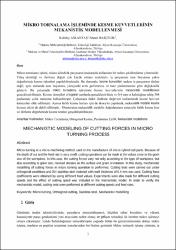| dc.contributor.author | Aslantaş, Kubilay | |
| dc.contributor.author | Hasçelik, Ahmet | |
| dc.date.accessioned | 2020-01-14T08:27:11Z | |
| dc.date.available | 2020-01-14T08:27:11Z | |
| dc.date.issued | Kasım 2019 | en_US |
| dc.identifier.citation | Aslantaş, K., Hasçelik, A. (2019). Mikro Tornalama İşleminde Kesme Kuvvetlerinin Mekanistik Modellenmesi. 10. Uluslararası Talaşlı İmalat Sempozyumu, Antalya, 7-9 Kasım. | en_US |
| dc.identifier.uri | https://www.utis.tc/ | |
| dc.identifier.uri | https://hdl.handle.net/11630/8078 | |
| dc.description.abstract | Mikro tornalama işlemi, mikro silindirik parçaların imalatında kullanılan bir mikro şekillendirme yöntemidir. Talaş derinliği ve ilerleme değeri çok küçük olması nedeniyle, iş parçasının tane boyutuna yakın değerlerinde kesme işlemleri yapılabilmektedir. Bu durumda, kesme kuvvetleri sadece iş parçasının türüne değil, aynı zamanda tane boyutuna, yüzeydeki artık gerilmelere ve tane yönlenmesine göre değişkenlik gösterir. Bu çalışmada mikro tornalama işleminde kesme kuvvetlerinin mekanistik modellemesi gerçekleştirilmiştir. Kesme deneyleri ortogonal şartlarda gerçekleştirilmiş ve 0,4 mm et kalınlığına sahip 304 paslanmaz çelik malzeme kullanılmıştır. Çalışmada farklı ilerleme değerleri kullanılarak kesme kuvveti katsayıları elde edilmiştir. Ayrıca farklı kesme hızları için de deneyler yapılarak, mekanistik modele kesme hızının etkisi de dahil edilmiştir. Oluşturulan mekanistik modelin doğrulanması amacıyla farklı kesme hızı ve ilerleme değerlerinde kesme testleri gerçekleştirilmiştir. | en_US |
| dc.description.abstract | Micro turning is a micro machining method used in the manufacture of micro cylindrical parts. Because of the depth of cut and the feed rate is very small, cutting operations can be made at the values close to the grain size of the workpiece. In this case, the cutting forces vary not only according to the type of workpiece, but also according to grain size, residual stresses on the surface and grain orientation. In this study, mechanistic modelling of cutting forces in micro turning operation is performed. Cutting tests were carried out under orthogonal conditions and 304 stainless steel material with wall thickness of 0.4 mm was used. Cutting force coefficients were obtained by using different feed values. Experiments were also made for different cutting speeds and the effect of cutting speed was included in the mechanistic model. In order to verify the mechanistic model, cutting tests were performed at different cutting speeds and feed rates. | en_US |
| dc.language.iso | tur | en_US |
| dc.publisher | UTIS 2019 | en_US |
| dc.rights | info:eu-repo/semantics/openAccess | en_US |
| dc.subject | Mikro Tornalama | en_US |
| dc.subject | Ortogonal Kesme | en_US |
| dc.subject | Paslanmaz Çelik | en_US |
| dc.subject | Mekanistik Modelleme | en_US |
| dc.subject | Micro Turning | en_US |
| dc.subject | Orthogonal Cutting | en_US |
| dc.subject | Stainless Steel | en_US |
| dc.subject | Mechanistic Modelling | en_US |
| dc.title | Mikro tornalama işleminde kesme kuvvetlerinin mekanistik modellenmesi | en_US |
| dc.title.alternative | Mechanistic modeling of cutting forces in micro turning process | en_US |
| dc.type | conferenceObject | en_US |
| dc.relation.journal | Uluslararası Talaşlı İmalat Sempozyumu (UTIS 2019) | en_US |
| dc.department | İscehisar Meslek Yüksekokulu | en_US |
| dc.authorid | 0000-0002-4615-0640 | en_US |
| dc.identifier.volume | 10th INTERNATIONAL CONGRESS ON MACHINING | en_US |
| dc.identifier.startpage | 1 | en_US |
| dc.identifier.endpage | 6 | en_US |
| dc.identifier.issue | 10 | en_US |
| dc.relation.publicationcategory | Konferans Öğesi - Uluslararası - Başka Kurum Yazarı | en_US |
| dc.contributor.institutionauthor | Aslantaş, Kubilay | |
| dc.contributor.institutionauthor | Hasçeli̇k, Ahmet | |



















